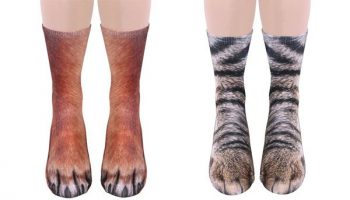
For all our readers that are fans of knitting, we have a special sock knitting project from which they can get some inspiration for their future works. It’s a challenging piece to do but it worth trying because the end results are really stunning. You can make the rainbow patch knitted socks with the help of the “entrelac technique” (check out the videos below), usually used to create textured diamond patterns, in most cases scarfs. Use as many colors you want but be careful because the more colors you use, the more complex this project is.
You start to knit the socks from the tiptoes area. Start with 2 knitting needles as you see in the picture and begin knitting the blocks one at a time in tiers. Each tier of blocks builds upon the one that is below it. Use the pictures for going further with the knitting. Be careful not to leave small holes in the corners of the squares. If the videos don’t help you, check out for a pattern here. We hope you will enjoy the making of the socks as much as you will enjoy wearing them in the end.

Keep being AllDayChic!








I simply love this pattern….how much does it cost? Is it free? Where can I get it? Need to make two pairs….one for my sister, and one for myself….undergoing cancer treatment and this would be an excellent project to keep me centered…
Please, check out for a pattern here: http://www.ravelry.com/patterns/library/lonely-socks-club-entrelac-sock
“Crochet sticks”??? No. Those are knitting needles. Crochet is a totally different technique and uses different tools.
Thanks for correction!
How do we get a pattern for the entrelac socks????
…gloria
Please, check out for a pattern here: http://www.ravelry.com/patterns/library/lonely-socks-club-entrelac-sock
Would LOVE the pattern for the Rainbow Entrelac Socks. I’m addicted to both sock knitting and entrelac so this would be nirvana for me !!!!
Please, check out for a pattern here: http://www.ravelry.com/patterns/library/lonely-socks-club-entrelac-sock
Is there a written pattern? or just the video?
Please, check out for a pattern here: http://www.ravelry.com/patterns/library/lonely-socks-club-entrelac-sock
Where can I get the pattern for the rainbow socks. Cheers
Please, check out for a pattern here: http://www.ravelry.com/patterns/library/lonely-socks-club-entrelac-sock
I have purchased the book that is listed in the Ravelry link you have posted, but it contains a pattern for a cuff down sock, not the toe up sock you are showing. It looks like you adapted this pattern to be toe up. Do you have a more detailed explanation of how you adapted the pattern to be toe up?